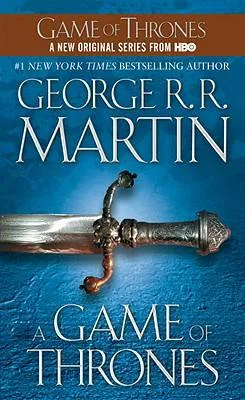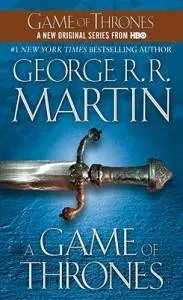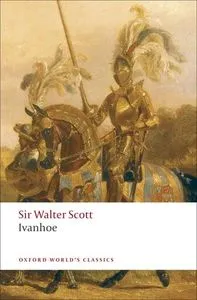
Read This, Then That: A GAME OF THRONES and IVANHOE
In Read This, Then That, we pair new books with classics that have similar themes, structures, and stories.
 That A Game of Thrones is fantasy is hard to dispute (without getting into deeper, more specific classifications than that, at least). It has dragons, undead, and giant wolves, after all, and it's set in a fictional world. But as I've watched the show over the years, and even more as I finally turned to the books, I continued to think less of dragons and their ilk and more of how utterly medieval Westeros and the rest of the world are. There are swords, and there is sorcery, but there is also a strong whiff of historical fiction in George R.R. Martin's epic.
That A Game of Thrones is fantasy is hard to dispute (without getting into deeper, more specific classifications than that, at least). It has dragons, undead, and giant wolves, after all, and it's set in a fictional world. But as I've watched the show over the years, and even more as I finally turned to the books, I continued to think less of dragons and their ilk and more of how utterly medieval Westeros and the rest of the world are. There are swords, and there is sorcery, but there is also a strong whiff of historical fiction in George R.R. Martin's epic.
The setting is undeniably feudal. There are lords and ladies, people swear oaths of fealty, and though it's spelled "Ser" instead of "Sir," knights are pretty much as we know them. They fight in tournaments to amuse the aristocracy and mob alike; yield to each other so they can later be ransomed even as the peasantry is slaughtered wholesale; and take ages to travel from York back to London—I mean, from Winterfell to King's Landing—after the king pays a visit to one of his principal vassals. Descriptions of clothing and food abound, minstrels sing ballads about earlier conquests, and who's descended from or related to whom is of paramount importance (and very complicated), and honor and chivalry live on (at least in theory).
Suggesting to fantasy enthusiasts or fans of a hit HBO series that they should turn next to Sir Walter Scott may sound like a bit much, but why should it? Ivanhoe is not exactly a short novel, but neither is any volume in A Song of Ice and Fire. And the two have much in common, especially in the types of characters driving the main action. Those types may play different roles—the plots are different, after all, though they too share commonalities—but the similarities are striking.
Robert Baratheon, for example, is the über-king of the Seven Kingdoms of Westeros at the outset of A Game of Thrones. He likes to drink, fight, whore, and hunt, all to excess. He also likes to spend a lot of borrowed money keeping himself and his people entertained. And even as king, he wants to continue the fighting he so enjoyed in his youth, though it's no longer proper for a royal personage who must keep himself safe as the head of state. Just so Richard Coeur de Lion, king at the time of Ivanhoe:
In the lion-hearted King, the brilliant, but useless character, of a knight of romance, was in a great measure realized and revived; and the personal glory which he acquired by his own deeds of arms, was far more dear to his excited imagination, than that which a course of policy and wisdom would have spread around his government. Accordingly, his reign was like the course of a brilliant and rapid meteor, which shoots along the face of Heaven, shedding around an unnecessary and portentous light, which is instantly swallowed up by universal darkness; his feats of chivalry furnishing themes for bards and minstrels, but affording none of those solid benefits to his country on which history loves to pause, and hold up as an example to posterity.
 Ned Stark, Robert's childhood friend, lord of Winterfell, and, as of the beginning of A Game of Thrones, the Hand of the King, is a very different sort of man. He adheres strongly and righteously to the ideals of his forefathers in House Stark, taking the moral path even when it leads to pain and suffering for himself, and doing what little he can to point out to the king the error of his wastrel ways. In Ivanhoe, this part is played by the title character, Sir Wilfrid of Ivanhoe, a close friend of King Richard who follows him into battle in the crusades and later back home in England. Like Ned, Wilfrid must find ways of gently pushing the king away from his own inclinations and toward a course more beneficial to the kingdom—without Richard's realizing he's being bossed by an underling.
Ned Stark, Robert's childhood friend, lord of Winterfell, and, as of the beginning of A Game of Thrones, the Hand of the King, is a very different sort of man. He adheres strongly and righteously to the ideals of his forefathers in House Stark, taking the moral path even when it leads to pain and suffering for himself, and doing what little he can to point out to the king the error of his wastrel ways. In Ivanhoe, this part is played by the title character, Sir Wilfrid of Ivanhoe, a close friend of King Richard who follows him into battle in the crusades and later back home in England. Like Ned, Wilfrid must find ways of gently pushing the king away from his own inclinations and toward a course more beneficial to the kingdom—without Richard's realizing he's being bossed by an underling.
There are others as well. How like is the "little bird" Sansa Stark, who knows nothing to say but the courtesies taught her as befitting a lady, to Rowena, a Saxon princess and barely-there heroine? And, as a contrast, Ivanhoe has Rebecca, a formidable healer and repeller of attacking knights, a role not dissimilar to Arya Stark's. The evil side of the coin is also well represented in both books: as Joffrey Baratheon, Ser Ilyn Payne, and Ser Gregor Clegane (among many, many others) delight in killing, maiming, and torture, so does the dastardly Norman, Reginald Front-de-Boeuf, who threatens to roast Rebecca's father alive in his dungeon.
Structurally, the two novels are somewhat different. Martin's books are fairly well known for their use of multiple points of view, sending a third-person narrator to follow various characters in turn. While Ivanhoe also switches off between multiple storylines so as to follow its panoply of characters through various events at different places but the same time, those shifts happen less frequently.
But if you've exhausted what Martin has written thus far, or enjoyed his work and wondered where to dive into an author as prolific as Scott, it's a good place to start—not least because it has its own element of, if not fantasy, at least the mythical. Robin Hood and his merry men are not exactly dragons or white walkers, but they too serve as familiar elements of a new story dressed in well-worn clothes. If you need a new battle-cry, a switch from "Winterfell!" to "Ivanhoe!" may not be a bridge too far.